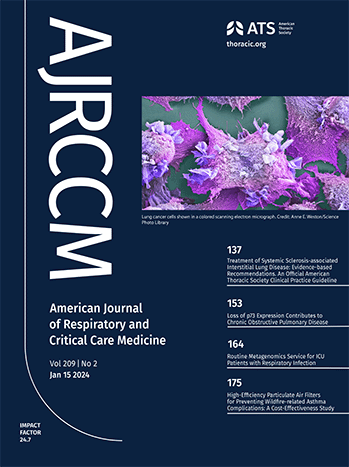血清免疫球蛋白 G 水平与病情恶化风险有关:SPIROMICS 分析。
IF 19.3
1区 医学
Q1 CRITICAL CARE MEDICINE
American journal of respiratory and critical care medicine
Pub Date : 2024-10-23
DOI:10.1164/rccm.202311-2184oc
引用次数: 0
摘要
理论依据血清免疫球蛋白 G (IgG) 缺乏与慢性阻塞性肺病 (COPD) 的发病率有关,但尚不清楚正常范围下限的浓度是否仍会带来风险。测量和主要结果研究了 SPIROMICS(n=1,497)中的吸烟者(n=1,026)和有慢性阻塞性肺病风险的吸烟者(n=471)。在一个子集(n=1,031)中,对 IgG 亚类进行了测量。通过多变量模型评估了总 IgG 或亚类与前瞻性病情加重之间的关系,并对人口统计学、目前吸烟情况、吸烟史、预测 FEV1%、吸入皮质类固醇和血清 IgA 进行了调整。结果IgG 的第 35 百分位数(该队列中为 1225 mg/dL)是阿凯克信息标准 (Akaike Information Criterion, AIC) 的最佳临界值。低于此值,病情恶化风险增加(IRR 1.28,95% CI 1.08-1.51)。在亚类别中,IgG1 和 IgG2 低于第 35 百分位数(分别为 354 和 105 mg/dL)均与严重病情恶化风险增加有关(IgG1:IRR 1.39,95% CI 1.06-1.84;IgG2:IRR 1.50,95% CI 1.14-1.1.97)。结论在慢性阻塞性肺病患者或高危人群中,血清 IgG 较低与病情恶化前瞻性相关。在亚类中,较低的 IgG1 和 IgG2 可能与严重的病情加重有关。最佳的 IgG 临界值远高于传统的缺乏临界值,这表明体液免疫的细微损伤可能与病情加重有关。本文章由计算机程序翻译,如有差异,请以英文原文为准。
Serum Immunoglobulin G Levels Are Associated with Risk for Exacerbations: An Analysis of SPIROMICS.
RATIONALE
Serum Immunoglobulin G (IgG) deficiency is associated with morbidity in chronic obstructive pulmonary disease (COPD) but it is unclear whether concentrations in the lower end of the normal range still confer risk.
OBJECTIVES
To determine if levels above traditional cutoffs for serum IgG deficiency are associated with exacerbations among current and former smokers with or at risk for COPD.
MEASUREMENTS AND MAIN RESULTS
Former and current smokers in SPIROMICS (n=1,497) were studied, n=1,026 with and n=471 at risk for COPD. In a subset (n=1,031), IgG subclasses were measured. Associations between total IgG or subclasses and prospective exacerbations were evaluated with multivariable models adjusting for demographics, current smoking, smoking history, FEV1% predicted, inhaled corticosteroids, and serum IgA.
RESULTS
The 35th percentile (1225 mg/dL in this cohort) of IgG was the best cutoff by Akaike Information Criterion (AIC). Below this, there was increased exacerbation risk (IRR 1.28, 95% CI 1.08-1.51). Among subclasses, IgG1 and IgG2 below 35th percentile (354 and 105 mg/dL, respectively) were both associated with increased risk of severe exacerbation (IgG1: IRR 1.39, 95% CI 1.06-1.84; IgG2: IRR 1.50, 95% CI 1.14-1.1.97). These associations remained significant when additionally adjusting for history of exacerbations.
CONCLUSIONS
Lower serum IgG is prospectively associated with exacerbations in individuals with or at risk for COPD. Among subclasses, lower IgG1 and IgG2 are prospectively associated with severe exacerbations. The optimal IgG cutoff was substantially higher than traditional cutoffs for deficiency, suggesting subtle impairment of humoral immunity may be associated with exacerbations.
求助全文
通过发布文献求助,成功后即可免费获取论文全文。
去求助
来源期刊
CiteScore
27.30
自引率
4.50%
发文量
1313
审稿时长
3-6 weeks
期刊介绍:
The American Journal of Respiratory and Critical Care Medicine focuses on human biology and disease, as well as animal studies that contribute to the understanding of pathophysiology and treatment of diseases that affect the respiratory system and critically ill patients. Papers that are solely or predominantly based in cell and molecular biology are published in the companion journal, the American Journal of Respiratory Cell and Molecular Biology. The Journal also seeks to publish clinical trials and outstanding review articles on areas of interest in several forms. The State-of-the-Art review is a treatise usually covering a broad field that brings bench research to the bedside. Shorter reviews are published as Critical Care Perspectives or Pulmonary Perspectives. These are generally focused on a more limited area and advance a concerted opinion about care for a specific process. Concise Clinical Reviews provide an evidence-based synthesis of the literature pertaining to topics of fundamental importance to the practice of pulmonary, critical care, and sleep medicine. Images providing advances or unusual contributions to the field are published as Images in Pulmonary, Critical Care, Sleep Medicine and the Sciences.
A recent trend and future direction of the Journal has been to include debates of a topical nature on issues of importance in pulmonary and critical care medicine and to the membership of the American Thoracic Society. Other recent changes have included encompassing works from the field of critical care medicine and the extension of the editorial governing of journal policy to colleagues outside of the United States of America. The focus and direction of the Journal is to establish an international forum for state-of-the-art respiratory and critical care medicine.

 求助内容:
求助内容: 应助结果提醒方式:
应助结果提醒方式:


